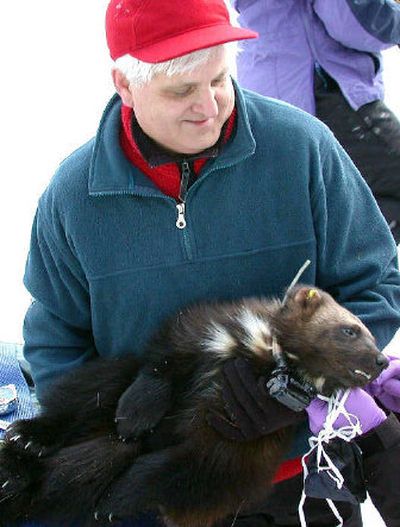Satellites spy on mysterious wilderness critter

Research biologists in Washington last week were celebrating the first live capture of a wolverine in the Pacific Northwest.
“To put it into perspective, experienced researchers near Yellowstone have had 28 traps out for quite a while and they haven’t caught one yet,” said Scott Fitkin, research biologist for the Washington Department of Fish and Wildlife.
“We put out three traps in January in western Okanogan County and we caught a young female wolverine on Feb. 10. We’re pretty happy.”
The young wolverine was sedated, fitted with a satellite transmitter and released so researchers could study the movements of one of the most secretive backcountry critters.
The study is headed by Keith Aubry, U.S. Forest Service carnivore expert for the Northwest Research Station based in Olympia.
“The trap is set so it would take something bigger than a marten to trip, and it has a transmitter we can monitor to tell if something gets into the trap,” Fitkin said. Reseachers say a wolverine could chew out of a log trap if they didn’t check within a couple of days.
The trap is specially designed like a log doghouse to be comfortable yet strong enough to hold what could be pound-for-pound one of the most powerful critters in the wilderness. It’s made of 8-inch logs because a wolverine would break its teeth trying to chew out of a metal trap.
Researchers from as far away as Missoula came quickly to ride snowmobiles to the capture site near the Pasayten Wilderness.
A trapped wolverine is unlike any other animal, said Jeff Copeland, a top researcher who’s been studying wolverines near Glacier Park for four years. Once researchers approach the trapped wolverine, it will throw a fit of hissing, spitting, snarling, gnashing and rumbling until it’s tranquilized.
It’s not a place for your hand, he told the Missoulian earlier this month, noting that, “I’ve had them take flashlights from people and just eat the whole thing, batteries and all.”
Copeland came to the Methow Valley to offer his experience in fitting the young female wolverine with the satellite radio collar.
“With this technology, we can now begin to gather reliable information on the movements, home range, and habitat of wolverines in the Pacific Northwest,” Aubry said.
With help from satellites 600 miles overhead, Aubry can track the wolverine’s movements simply by logging onto his office computer.
The wolverine is federally listed as a sensitive species and a candidate for protective listing in Washington.
“They are probably the lowest-density carnivore in North America, maybe the world,” Copeland said, noting that only a half-dozen wolverines might be found in 500 square miles of suitable habitat.
The most dependable wolverine populations in the lower 48 states are in Montana, he said.
Since the mid-1990s, Fitkin and Forest Service biologists have documented the presence of wolverines in northcentral Washington using aerial surveys, remote cameras and winter tracking.
In all those years, Fitkin said he has seen only one other live wolverine in the Okanogan.
“I think I was in 2000,” he said. “I was in a helicopter and we were checking out a possible den site about 10 miles north of where we caught this wolverine. I was looking down and an adult came out of the hole and ran into the trees.
“It’s always been our wish to get enough information together to lead to this kind of satellite project,” he said. Wolverines are the largest land-based member of the mustelid family that includes weasels, badgers, and otters. They weigh 20 to 40 pounds and are found primarily in boreal forest and tundra habitats in the far north, but also occur in mountainous terrain at the southern end of their current range in the Cascades and Northern Rockies. They prey on everything from deer to mice, and scavenge for much of their food during winter.
“We honestly don’t know exactly how they survive during winter because they tend to stay up high where there’s not a lot of game,” Fitkin said. “But we know they travel long distances and that’s probably because they use their extraordinary noses to seek out things like hunting gut piles even though they might be under 10 feet of snow. They’re very strong diggers. They can find mountain goats buried in avalanches.”
“The young female wolverine we collared weighed 19 pounds, and was in excellent condition,” Aubry said. “She hasn’t had kits yet, and is probably just a year old. It’s likely her parents and possibly siblings are in the same general area, so chances are good that we will collar additional individuals in the traps we’ve set.”